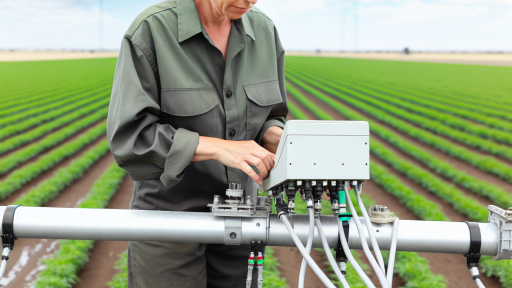Introduction to Robotics in Agriculture
The Rise of Agricultural Robotics
Robotics technology has made significant strides in agriculture.
Farmers adopt automation to enhance productivity.
This shift aligns with the growing demand for food.
Furthermore, robots help tackle labor shortages in farming.
Benefits of Robotics on the Farm
Implementing robotics provides various advantages.
First, it increases operational efficiency across tasks.
Additionally, robots can perform repetitive tasks with precision.
This reduces human errors and improves crop yields.
- Enhance precision in planting and harvesting.
- Reduce costs associated with labor and machinery.
- Improve monitoring with data collection through sensors.
Types of Agricultural Robots
Various types of robots benefit modern farming.
These include autonomous tractors and drones.
Robots also assist with tasks like weeding and crop inspection.
- Autonomous tractors navigate pre-defined paths.
- Drones provide aerial monitoring for crop health.
- Robotic arms automate packing in warehouses.
Challenges in Implementing Robotics
Despite their benefits, robotic systems present challenges.
High initial costs deter some farmers from investing.
Additionally, there may be a learning curve for staff.
Moreover, technical failures can disrupt farming operations.
Transform Your Agribusiness
Unlock your farm's potential with expert advice tailored to your needs. Get actionable steps that drive real results.
Get StartedFarmers must weigh these challenges against potential gains.
Benefits of Using Robotics on Farms
Increased Efficiency
Robotics significantly enhance operational efficiency on farms.
Automated systems reduce the time needed for tasks such as planting and harvesting.
This leads to faster crop cycles and increased outputs.
Moreover, robots can operate continuously, maximizing productivity.
Cost Reduction
Integrating robotics can lower labor costs significantly.
Farms reduce their reliance on manual labor, which is often expensive.
Additionally, robots can minimize errors, avoiding costly mistakes in operations.
Furthermore, automation offers the potential for predictable expenses throughout the year.
Improved Precision
Robots provide a level of precision that is hard to achieve manually.
They can apply fertilizers and pesticides at optimal rates, reducing waste.
This precision enhances crop yields and quality.
Consequently, farms can meet market specifications more efficiently.
Enhanced Safety
Robotics can take over hazardous tasks on farms.
This reduces the risk of injury among farm workers.
Additionally, robots can operate in adverse weather conditions.
As a result, safety improves for human operators and livestock.
Data Collection and Management
Robots facilitate real-time data collection on crop health.
This data informs better decision-making processes.
Using analytics, farmers can identify trends and forecast issues early.
Moreover, data management systems can optimize resource allocation.
Types of Agricultural Robots and Their Applications
Autonomous Tractors
Autonomous tractors revolutionize how we cultivate land.
They operate without human intervention, enhancing efficiency.
These tractors can maneuver through fields accurately.
Showcase Your Farming Business
Publish your professional farming services profile on our blog for a one-time fee of $200 and reach a dedicated audience of farmers and agribusiness owners.
Publish Your ProfileFarmers increase productivity while reducing labor needs.
Additionally, autonomous tractors use GPS for precision farming.
Harvesting Robots
Harvesting robots automate the picking of crops.
These robots minimize damage to fruits and vegetables.
They operate in various weather conditions, maximizing harvest time.
Companies like Harvest Automation develop specialized robots for this task.
Furthermore, they help to address labor shortages in agriculture.
Seeding and Planting Robots
Seeding and planting robots streamline crop establishment.
They ensure seeds are planted at optimal depths and spacing.
This technology enhances germination rates and yield potential.
Companies like Ecorobotix provide innovative solutions in this area.
Farmers benefit from improved accuracy and efficiency in planting.
Pest Control Robots
Pest control robots target pests without harming crops.
They use advanced sensors to identify pest infestations.
With this technology, farmers reduce pesticide usage significantly.
As a result, this approach supports sustainable farming practices.
Moreover, these robots can operate autonomously, saving time.
Soil Monitoring Robots
Soil monitoring robots analyze soil health and composition.
These tools provide valuable insights into nutrient levels.
Farmers can make informed decisions about fertilization.
This technology also aids in irrigation management.
Consequently, it enhances crop health and overall yield.
Uncover the Details: Training Your Team For Robotic Farming
Assessing Your Farm’s Needs for Automation
Identifying Key Areas for Improvement
Begin by evaluating the current operations on your farm.
Identify tasks that require significant labor and time.
Consider which processes affect your yield and efficiency the most.
Automation can streamline repetitive tasks effectively.
For instance, planting, watering, and harvesting are prime candidates.
Assessing Technological Readiness
Next, review the existing technology on your farm.
Determine if your infrastructure supports advanced automation solutions.
Older equipment may need upgrades to integrate with new systems.
Conduct a technology audit to identify gaps and opportunities.
This assessment informs your long-term automation strategy.
Defining Budget Constraints
Establish a clear budget for implementing robotics on your farm.
Evaluate the costs associated with purchasing and maintaining robotic systems.
Consider potential savings from reduced labor and increased productivity.
Additionally, explore funding options and grants for agricultural innovation.
Align your budget with your operational goals to prioritize spending.
Engaging Stakeholders
Include key stakeholders in the assessment process.
Consult with employees who understand daily operations.
Showcase Your Farming Business
Publish your professional farming services profile on our blog for a one-time fee of $200 and reach a dedicated audience of farmers and agribusiness owners.
Publish Your ProfileGather input from agronomists or technology specialists.
Feedback from these parties can highlight practical automation needs.
Collaboration fosters a shared vision for your farm’s automation journey.
Creating a Prioritized Action Plan
Finally, develop a detailed action plan based on your assessments.
Prioritize tasks that offer the greatest impact on efficiency and yields.
Set timelines for implementing each phase of automation.
Regularly review and adjust the plan as needed.
Staying flexible allows you to adapt to new technologies or methods.
You Might Also Like: Smart Irrigation Systems Powered By Robots
Choosing the Right Robotic Solutions for Your Farm
Identifying Your Farm’s Needs
First, assess your farm’s specific requirements.
Consider the tasks that consume the most time and resources.
Next, identify areas where automation can boost efficiency.
Focus on the types of crops and livestock you manage.
Understanding these factors will guide your robotic solution choices.
Exploring Available Robotic Technologies
Different robotic technologies offer unique benefits.
- Robots for planting can improve seed placement accuracy.
- Harvesting robots reduce labor costs significantly.
- Weeding robots minimize the need for chemical herbicides.
Evaluate the technologies available on the market.
Research manufacturers and their specific offerings thoroughly.
Assessing Integration and Compatibility
Ensure that new robots can integrate with existing equipment.
Compatibility is crucial for smooth operation on your farm.
Consider the software platforms used for farm management.
Choose robots that can easily communicate with those systems.
Budgeting for Robotic Solutions
Establish a clear budget for robotics on your farm.
Include both initial investment and ongoing maintenance costs.
Explore financing options available through various platforms.
Some companies offer leasing or subscription models.
Evaluating Vendor Support and Service
Look for vendors that provide comprehensive support services.
Training for your staff is equally important for successful deployment.
Consider the availability of local service personnel.
Good technical support will minimize downtime in critical situations.
See Related Content: Energy Efficient Vertical Farming Techniques for Farmers

Integrating Robotics with Existing Farm Equipment
Assessing Current Equipment
Begin by evaluating your existing farm machinery.
This step identifies equipment compatible with robotics.
Review the condition and capabilities of every machine.
Consider any upgrades necessary to enhance compatibility.
Identifying Robotic Solutions
Research available robotic technologies suited for agriculture.
Explore options like autonomous tractors and robotic harvesters.
Analyze how these robots can work alongside your equipment.
Gather feedback from other farmers using similar technologies.
Creating a Compatibility Plan
Draft a plan outlining how to integrate robotics effectively.
List the specific equipment that will receive robotic upgrades.
Showcase Your Farming Business
Publish your professional farming services profile on our blog for a one-time fee of $200 and reach a dedicated audience of farmers and agribusiness owners.
Publish Your ProfileDetermine modifications needed for each piece of machinery.
This plan will guide smooth integration without disruptions.
Training and Implementation
Provide thorough training for your team on new technologies.
Ensure everyone understands the robotic systems’ operation.
Schedule hands-on sessions for practical experience.
Establish a timeline for phased implementation of robotics.
Monitoring Performance
Set up a system to track the performance of robotics.
Analyze data on efficiency and productivity regularly.
Make adjustments as needed based on performance metrics.
This ongoing assessment will optimize your integration strategy.
Find Out More: Automated Machinery for Precision Agriculture
Training and Supporting Staff for Robotic Operations
Importance of Training
Robotic technology transforms farming operations significantly.
It is crucial to train staff properly for effective integration.
Training ensures team members understand new systems and processes.
Well-trained staff can enhance productivity and safety.
Creating a Training Program
A structured training program is essential for success.
Start with an overview of robotic systems and capabilities.
Next, include hands-on sessions to build practical skills.
Utilize various training formats for diverse learning preferences.
- Workshops for group learning.
- Online modules for self-paced education.
- One-on-one coaching for individualized support.
Engaging and Supporting Staff
Engagement is key to achieving high levels of employee buy-in.
Encourage feedback during training sessions to improve content.
Provide ongoing support to address challenges as they arise.
This support can come in many forms.
- Regular check-ins to discuss progress.
- Access to resources for additional learning.
- Creating a mentorship program for ongoing guidance.
Evaluating Training Effectiveness
Evaluating the training program helps identify strengths and weaknesses.
Implement assessments after training sessions to gauge knowledge retention.
Gather participant feedback to refine future training initiatives.
Track performance metrics to measure productivity improvements.
Future Trends in Agricultural Robotics and Technology
Advancements in Robotic Automation
Robotic automation continues to transform agricultural practices.
New devices enhance efficiency and reduce the need for human labor.
Farmers increasingly adopt automated machinery for harvesting and planting.
Additionally, autonomous drones assist with crop monitoring and analysis.
Integration of Artificial Intelligence
Artificial intelligence plays a crucial role in modern agriculture.
AI systems analyze data to improve decision-making processes.
Predictive analytics enables proactive pest management strategies.
Moreover, AI-driven insights help optimize resource allocation.
Use of IoT Technologies
The Internet of Things (IoT) is reshaping agricultural practices.
Sensors connected to the cloud provide real-time data access.
This technology enhances precision farming techniques significantly.
Farmers can monitor soil conditions, weather patterns, and crop health efficiently.
Development of Sustainable Tools
Robotics also drives the creation of sustainable farming tools.
Showcase Your Farming Business
Publish your professional farming services profile on our blog for a one-time fee of $200 and reach a dedicated audience of farmers and agribusiness owners.
Publish Your ProfileInnovative equipment minimizes waste and reduces environmental impact.
For instance, seeders equipped with robotics ensure precise planting.
These tools effectively conserve resources such as water and fertilizers.
Collaboration with Tech Companies
The agricultural sector increasingly collaborates with technology firms.
Startups focus on developing innovative solutions for farmers.
Partnerships promote the integration of technology into everyday farming.
Several companies fund research initiatives to explore new agricultural methods.
Rising Demand for Data Analytics
Data analytics usage is on the rise in agriculture.
Farmers analyze data trends to forecast yields and optimize production.
Advanced analytics tools enhance the accuracy of business decisions.
In turn, this promotes better alignment with market demands.
Emphasis on Workforce Training
As technology evolves, workforce training becomes essential.
Farmers must adapt to new tools and systems efficiently.
Training programs provide the necessary skills for operating advanced machinery.
Farmers who invest in education will likely see greater productivity.
Additional Resources
Agriculture Innovation: 10 Tech Trends to Watch in 2023 …
US farms are making an urgent push into AI. It could help feed the …




